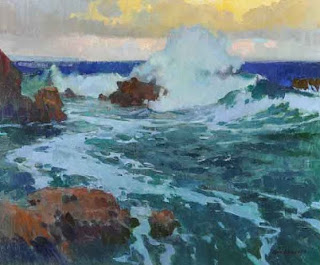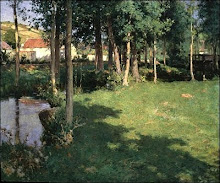Storm in Harvest, 1856
source: art inconnu
Saturday, December 25, 2010
Friday, December 10, 2010
Color Loudness
Bright colors are popular with many art buyers, and many painters, realising this, tend to indiscriminately exaggerate color regardless of the subject and lighting conditions and mood. The result is that their work can seem unconvincing. (which is not to say that photographic accuracy should be the aim). The loudness is stimulating initially, but soon becomes tiring.
However, the intense colours in these beautiful landscapes, by the American artist Mark Kerckhoff, are appropriate, as his subjects here are arid badlands where the light is intense.
Vibrancy of color is not achieved by simply turning up the 'volume' of color, but by an understanding of complementarities.
Sizes:
Top: 20 x 24 inches
Bottom: 12 x 16 inches.
Sizes:
Top: 20 x 24 inches
Bottom: 12 x 16 inches.
Wednesday, November 24, 2010
Wednesday, November 17, 2010
James Perry Wilson
Wilson had a masterly control of tonal values.
His simple palette consisted of the primary colors: three blues, three yellows and three reds.
Permalba white
Ultramarine blue
Cobalt blue
Winsor blue
Cadmium yellow pale
Cadmium yellow deep
Yellow ochre
Alizarin crimson
Cadmium scarlet
Indian red
Source: www.peabody.yale.edu
His simple palette consisted of the primary colors: three blues, three yellows and three reds.
Permalba white
Ultramarine blue
Cobalt blue
Winsor blue
Cadmium yellow pale
Cadmium yellow deep
Yellow ochre
Alizarin crimson
Cadmium scarlet
Indian red
Burnt umber, cadmium pale green for highlighting leaves, and cadmium lemon were also used with less frequency.
He primed his supports with brilliant white oil paint that lent a brilliance to the colors layed over it. He used the Impressionist technique of optical mixing of colors but was careful to make them of the same tonal value. Wilson describes his method for painting a vibrant sky.
Set out three dabs of white (or four, if you want to use two blues). With one mix a tint of ruby madder, with one a tint of cadmium, and with the remaining one (or two) tints of blue. In working the color into the white, you can produce a graduated tint, covering the range of values you will want in your sky. Then from the deepest part of the tints you can mix a color for the top of the sky. As you come down, use successively lighter parts of the tints. An effective way of mixing the color from the three tints is not to use a knife, but to pick up a bit of each tint directly with your brush. Stir them together only lightly, so that they are not too thoroughly mixed. Then you will get a suggestion of broken color, in a free, loose way. In preparing the three (or four) tints, be careful to make the values correspond; for in broken color it is important to have your values the same; otherwise the colors will never flow together and produce vibration. This, to my mind, is the failing of the French Impressionist painter Seurat. He uses dots of color of varying values and they remain just dots of color, never uniting to the eye as Monet's do.
Source: www.peabody.yale.edu
Daniel Graves
Given that we do not want to just repeat the work of past centuries, I think one of the great challenges we face is that of discovering what we are going to paint and sculpt. To merely record the surface appearance of "reality"? has never been the province of painting, whose language is far deeper. From the beginning, artists have painted, sculpted, and drawn things that had meaning for them, and the images they have left behind are a living testament, a record of their consciousness on earth.
To continue the testimony of what humans have seen, believed, felt, and thought, we must have the courage to ask ourselves what we really care about, because if we do not know we cannot express it. We must develop our capacity for deep feeling, for what we know with our minds is only part of what we have to give to our art—we also have our hearts to give. Today many of us are adults in our minds but children in our hearts. We must grow wise in our hearts, in tandem with honing our craft, in order to express ourselves in a way that will both touch and be meaningful to others. To seek beauty and meaning in our lives is to bring it into our art.
-Daniel Graves
Tuesday, November 16, 2010
Radiating Lines
A nice plein air study.
The apparently quiet and simple subject forms a dynamic and interesting composition because of radiating lines, diagonal movements of the banks of the stream and the central mass of trees, pulling away from each other but also drawing the eye into the heart of the scene.
The small patches of light seen between the trees on the horizon are almost pure white, while the shadows reflected in the stream are almost pure black. This gives the painting the full range of tonal contrast.
Thursday, November 11, 2010
WC Piguenit
Kosciusko
William Charles Piguenit, 1836-1914, Australian.
William Charles Piguenit, 1836-1914, Australian.
Unassuming and retiring, he shrank from controversy and quietly resigned from the Art Society of New South Wales when it split over the impressionist movement. The first Australian-born artist of note, he delighted in mountain scenery and often chose dramatic subjects for his painting.
Mount Kosciusko is the highest point in Australia.
Read more about Piguenit on a very interesting blog I follow: Art and Architecture, Mainly
Mount Kosciusko is the highest point in Australia.
Read more about Piguenit on a very interesting blog I follow: Art and Architecture, Mainly
Wednesday, October 27, 2010
Tuesday, October 19, 2010
Frederick Edwin Church
Great Basin, Mt Katahdin, Maine.
Church has used complementary opposite colors (yellow/violet) for vibrancy, adding yellow to the green lower slopes, and adding subtle hints of violet in the shadows of the cliffs above.
Sunday, October 3, 2010
Subtle Brushwork
François Biard, Magdalena-Bay, vue prise de la presqu'île des tombeaux, au nord du Spitzberg; effet d'aurore boréale. Louvre Museum.
Source: art inconnu
Source: art inconnu
Wednesday, September 22, 2010
James David Smillie - American 1833-1909
The color white is often underused by landscape painters, except mixed with other colors. In this piece (and in the examples in the previous few posts) white is used to make a dramatic contrast to shadows and dark foliage.
Monday, September 13, 2010
Conveying an impression of Vastness
Friday, September 10, 2010
Saturday, August 14, 2010
L-shaped composition
Klimt was a master of composing in a square format. He probably favoured the square because it tends to bring out the abstract or architectural qualities of a scene. Though the shapes in this L-shaped composition are quite minimalist, he fills them with interesting textures, applied randomly, but the eye is tricked into seeing fine, realistic detail.
Chiaroscuro
The Australian painter John Anderson makes use of chiaroscuro - strong contrasts between light and dark - to give his images power. This landcape is rather like a charcoal study, and indeed chiaroscuro originated during the Renaissance as drawing on toned paper, where the artist worked from this base mid tone towards light, with white gouache, and towards dark, with ink, bodycolour or watercolour. Chiraoscuro can suggest a dream-like world in which images emerge from the dark background of the subconscious.
Saturday, July 31, 2010
Tuesday, July 20, 2010
Saturday, June 5, 2010
Bierstadt
Cathedral Rocks
This German American painter is one of my favourites. His subjects are often dramatic and sublime.
This German American painter is one of my favourites. His subjects are often dramatic and sublime.
Friday, May 28, 2010
Josef Willroider - German 1838-1915
17 x 32 cm
The brushwork in this little piece (stumbled upon on an art auction website) is wonderfully eloquent and efficient (how German). Right-leaning diagonal marks in the sky balance the left-leaning reeds.
Tuesday, May 25, 2010
Complementary Colours
George Carlson, American, In the Shadow of the Sun, 42 x 42 inches
Subtle hints of pink lend radiance to the predominantly green palette. There's just the right amount of the complementary colour to create a vibration. Too much and the vibration becomes oscillation, and the sense of peace in the work is lost. The square format enhances the abstract qualities of the piece.
Here's a link to the artist's biography.
Subtle hints of pink lend radiance to the predominantly green palette. There's just the right amount of the complementary colour to create a vibration. Too much and the vibration becomes oscillation, and the sense of peace in the work is lost. The square format enhances the abstract qualities of the piece.
Here's a link to the artist's biography.
Friday, May 14, 2010
Monday, May 3, 2010
Greek Landscape Painting
Vikentios Bokatsiambis, View of the Church of St Nikolas, Athens, 28.3 x 58 cm
Michalis Economou, 1888-1933, Les Buissons, 38.5 x 46 cm
Michalis Economou, 1888-1933, Les Buissons, 38.5 x 46 cm
Thursday, April 29, 2010
Ivan Aivazovsky - Armenian/Russian
In Aivazovsky's landscapes light penetrates shadow and mist, conveying a sense of mystical grandeur.
Sunday, March 7, 2010
Thomas Paquette - American
These works have a wonderful mystical feel. I think the medium is oil, but, if I remember correctly, this artist also uses pastels, and may have wanted to bring something of pastel technique into oil painting. Some oil painters squeeze their paint out onto absorbant paper to take out as much oil as possible, this gives their work a chalkier appearance. I believe Monet did this.
Albert Goodwin - British
The Sultan and his Camp by the Enchanted Lake 1888
I think this work is hanging in the Art Gallery of New South Wales.
I think this work is hanging in the Art Gallery of New South Wales.
Saturday, January 30, 2010
Edgar Payne - American
Payne is fairly famous in the US for his images of cowboys riding through canyons; images that were so often copied by later artists that they came to be seen as cliched.
There's a great strength in the composition of this scene which lifts the work above the run of the mill.
Subscribe to:
Comments (Atom)















.jpg)





















.jpg)













+1900.bmp)